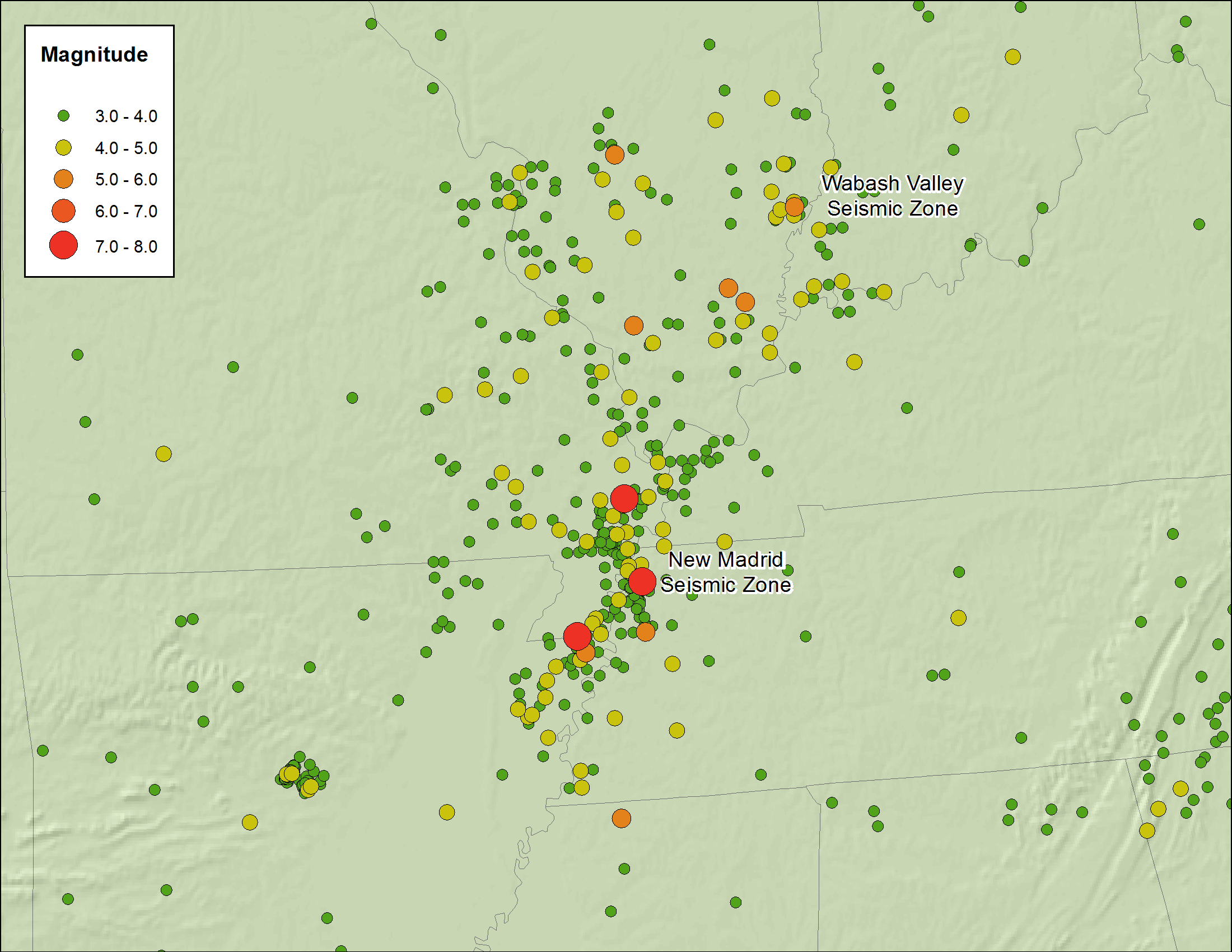The central and eastern regions of the U.S. have far fewer earthquakes than the West but have areas with risk due to intraplate deformation. Significantly, on February 7, 1812, the town of New Madrid, Missouri, some 1,200 miles from the nearest plate boundary, was destroyed by an earthquake of about M 7.4–8.6. This was the last major event in what seismologists today characterize as a "correlated triplet."
The three earthquakes, which are among the largest historical earthquakes known to have struck the continental U.S., occurred in the winter of 1811–1812 along the New Madrid Seismic Zone (NMSZ), which comprises Arkansas, Illinois, Indiana, Kentucky, Missouri, Ohio, and Tennessee.
The first of them struck in what is now northeast Arkansas on December 16, 1811, and measured about M7.2–8.0; six aftershocks in the range of M5.5-6.3 followed in the next two days. The second was an M7.0-8.0 earthquake on January 23, 1812, with its epicenter in the Missouri Bootheel, an area in the southeasternmost part of the state. The third and most widely felt was the one that struck near New Madrid; in addition to the correlated triplet, thousands of weaker earthquakes occurred during this period and aftershocks continued for years.
Shaking from the New Madrid earthquake was felt across an area of roughly 50,000 square miles from Cairo, Illinois, to today's Memphis, Tennessee. People in New York City and Montreal were aware of it, church bells in Charleston, South Carolina, were set ringing by it, and in Washington, D.C., President James Madison and his wife felt it in the White House.
Closer to the epicenters of the three major quakes, land lifted up and down in places, exposing tree roots and creating fissures in the ground. Some locations experienced liquefaction, and sand boils formed, among them the world's largest at 1.4 miles long and 136 acres in extent, known to locals today as “The Beach.” The landscape changed as a result of landslides and subsidence, which reached 6 meters in places, forming the 4-mile-long Reelfoot Lake in northwestern Tennessee 15 miles south of New Madrid. Riverbanks collapsed, old channels vanished and new ones appeared, and islands were lost. Uplift created a temporary waterfall on the Mississippi and had the river flowing in reverse for several hours.
At the time, New Madrid was a settlement of about 5,000 people in a sparsely populated frontier territory acquired by the United States as recently as 1803 as part of the Louisiana Purchase. Property damage was minimal and largely limited to fallen chimneys or damage caused by falling trees. Some homes collapsed and only one life was reportedly lost in a structure, although some other people were reported missing.
The United States Geological Survey (USGS) notes that “the geologic record of pre-1811 earthquakes reveals that the New Madrid seismic zone has repeatedly produced sequences of major earthquakes, including several of magnitude 7 to 8, over the past 4,500 years” (Figure 1). Recent research that re-examined intensity data and physical models relating to the events of 1812 suggests that M6.8–8.0 events are possible, and even larger earthquakes may occur on the central and southern segments of the fault zone.

Today, New Madrid’s population is a little more than 3,000, but the New Madrid Seismic Zone retains the potential to produce large and destructive quakes and the potential for loss in the region is concerning. In 1812 level IX shaking on the Modified Mercalli Intensity scale was experienced in the location of today’s city of Memphis, Tennessee. Among them, the greater St. Louis metropolitan area in Missouri; Louisville, Kentucky; and Nashville and Memphis, Tennessee, have a population of about 7.2 million people. In a 2009 report funded by the Federal Emergency Management Agency (FEMA), the Mid-America Earthquake Center estimated that a repeat of the events of 1811-12 could result in nearly 86,000 injuries and 3,500 fatalities in the region.
The scientific consensus is that another New Madrid earthquake can indeed happen. But when might it occur? The USGS estimates that there is a 7 to 10% chance that an event like the one in 1811/12—that is, an earthquake having a magnitude of 7.0 or more—could occur within the next 50 years. There is, however, considerable uncertainty about what happened seismologically in the winter of 1811/12 and how a future recurrence might play out.
Read “Earthquake Risk in the United States: A Major Model Update“




